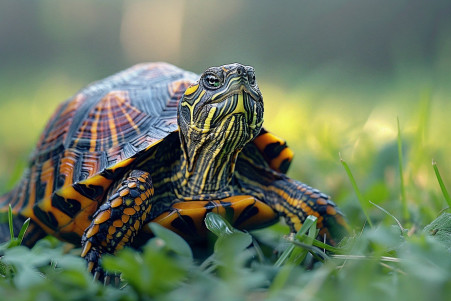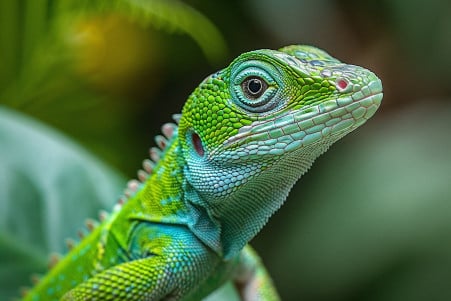From Hisses to Barks: A Look at the Vocal Talents of Lizards
15 May 2024 • Updated 15 May 2024

With more than 6,000 species of lizards on the planet, it may come as a surprise that many of them are vocal animals. While most lizards don’t have vocal cords, they can still make sounds through other means, including hissing, grunting, barking, and even complex calling behaviors. These sounds are used for a variety of reasons, including communication and territorial defense. For example, some geckos are known for their vocalizations, and some iguanas make deep, guttural sounds. So, while they may not be as loud as some other species, lizards are vocal animals in their own right.
This article will explore the findings of studies in the fields of herpetology, ethology, and bioacoustics that have shown the wide range of sounds that lizards can make. By reviewing research on the vocal behaviors and vocal capabilities of lizards, including the physical ways they produce sounds, you’ll learn about the rich, but often overlooked, world of sound that these reptiles inhabit. In addition, learning about their acoustic communication can help you understand their social systems, mating systems, and evolutionary history.
Do lizards make noise?
Anatomy and Physiology of Lizard Vocalizations
The anatomy and physiology of lizards show a number of specializations that have enabled their vocal abilities. Lizards have a range of structural differentiation in the inner ear and cochlea, which has led to differences in hearing ability. For example, geckos have a high level of cochlear differentiation similar to higher vertebrates, which allows them to hear frequencies as high as 10,000 Hz. Although most lizards don’t have true vocal cords, some have the ability to produce sounds through modifications of the upper respiratory tract or larynx.
One of the most important things to note is that lizards have relatively large lungs that are used not only for respiration but also for vocalization, display behaviors, and buoyancy control. The differences in vocal mechanisms between different groups of lizards suggest that true vocal abilities have evolved independently in lizards multiple times. For example, geckos are actually able to vocalize rather than just rapidly expelling air to hiss, and their vocalizations may be used in territoriality and social interactions.
The lizard ear has both auditory and vestibular functions. While the external ear is reduced or absent in some species like geckos and monitors, in most species, the external ear is visible as a tympanic membrane that is covered by a thin layer of skin that is shed during ecdysis. The ear contains a single auditory ossicle called the columella that transmits vibrations from the eardrum to the inner ear. The differences in hearing structures have led to the wide range of acoustic perception and vocalization seen in lizards.
The Wide Range of Lizard Vocalizations
Lizards have been shown to produce a variety of sounds, including hisses, grunts, barks, chirps, clicks, and more complex calls. National Geographic explains that the sounds lizards make can vary based on the species, the size of the lizard, and the context or function of the vocalization. For example, some species of lizards, including some geckos and the tuatara, have been found to make croaking or clicking sounds during courtship and territorial interactions. The Gekkota website adds that geckos are especially vocal, especially at night when they are most active, and can be heard making "chirps, clicks, and barks" to communicate with other geckos.
Larger lizards, such as iguanas and monitor lizards, tend to make lower-pitched, more guttural sounds, including grunts and hisses. As the Wiley Online Library article explains, some lizard vocalizations can be heard by humans, while others may be too high- or low-pitched to be audible. This wide range of vocalizations demonstrates the complex communication skills of these often underappreciated reptiles.
Why Do Lizards Make Noise?
Lizards vocalize for a number of reasons, including territorial defense, courtship and mating, predator avoidance, and social communication. According to the Herpetoculture Network, many nocturnal gecko species use vocalizations for territorial and mating displays because visual signals are less effective in low-light environments. Meanwhile, distress calls and hissing sounds can help lizards defend themselves by warning off predators and other threats.
For example, a study of the Pristidactylus grunter lizard determined that the lizards "emit oral sounds specifically when threatened by predators" in order to signal their distress. The research published in Animals also found that the lizards' hisses may provide "honest information on individuals' ability to escape" and that the sounds may be "perceived differently by conspecifics and predators." Lizard vocalizations may also help maintain social order and dominance within lizard groups.
The wide range of reasons why lizards make noise, from mating to avoiding predators, shows that lizards have a complex vocal communication system. Studying lizard vocalizations can help scientists learn more about how vocal communication in lizards has evolved.
Evolutionary History of Lizard Vocal Communication
More recent research has shown that the ability to make sounds likely originated in the last common ancestor of all major groups of terrestrial vertebrates, which lived about 407 million years ago. An international team of researchers was able to reconstruct acoustic communication as a shared ancestral trait of these animals, which include turtles, tuataras, caecilians and lungfishes, according to ScienceDaily.
The widespread evidence of acoustic behavior across various lizard families, including those that were previously considered non-vocal, points to a common evolutionary origin of vocal communication. Meanwhile, a study published in The Proceedings of the Royal Society B showed that reptile vocalizations are more flexible than previously assumed, with geckos demonstrating vocal plasticity, or the ability to change their calls based on environmental factors such as noise. This indicates a sophisticated sender-receiver coevolution in lizard communication systems.
The origins of vertebrate sound communication are linked to a nocturnal lifestyle, as Scientific American explains, which is advantageous when visual cues are unavailable. Although the ability to vocalize doesn’t necessarily increase diversification rates, as ScienceDaily explains, it’s probably evolutionarily conserved because of the advantages it provides to lizards.
Preserving Lizard Vocalizations and Communication
The study of lizard vocalizations and communication has important implications for researchers, conservationists, and lizard lovers. Per LizardPedia, research on lizard calls can help scientists learn more about lizard behavior, social structure, and survival techniques, which can help them create more targeted conservation plans.
Thanks to technological breakthroughs, researchers have been able to delve more deeply into lizard vocalizations and learn more about the acoustic diversity of these creatures. The WSAVA 2016 Congress report notes that these breakthroughs have helped scientists make great strides in recording and analyzing the nuances of lizard calls.
It’s important to protect vocal lizard species and the environments in which they live in order to preserve this aspect of their natural behavior and communication skills. As the Max Planck Institute for Ornithology explains, the flexibility and complexity of lizard vocalizations is much greater than previously thought, which means it’s important to protect their acoustic diversity.
When working to protect lizard species, it’s important to take into account the potential impact on their acoustic signaling and the role it plays in their lives. By learning about and protecting the wide range of sounds that lizards make, we can learn more about their evolutionary history and ensure that these fascinating reptiles continue to thrive.
Conclusion: The Surprisingly Diverse Vocalizations of Lizards
While often overlooked, many lizard species possess the ability to produce a diverse range of vocalizations and sounds. From simple hisses and grunts to complex calls and songs, lizards use vocalizations for various purposes, including territorial defense, courtship, predator avoidance, and social communication.
The anatomical and physiological adaptations that enable lizard vocalizations, as well as their evolutionary origins, highlight the sophistication of their communication systems. Understanding and conserving the acoustic diversity of lizards is important for researchers, conservationists, and enthusiasts alike, as it provides insights into their behavior and aids in protecting these unique abilities.
The often overlooked vocal world of lizards offers a fascinating glimpse into the complex and diverse ways in which these reptilian creatures communicate and interact with their environment.


